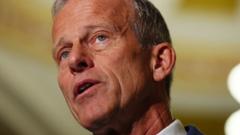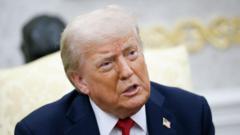India's economy has displayed signs of weakening momentum with recent GDP figures suggesting a decline in consumer demand and investment, prompting debates on the durability of its growth narrative.
**Is India's Economic Momentum Slowing Down?**

**Is India's Economic Momentum Slowing Down?**
With GDP growth retreating to a seven-quarter low, concerns mount over India's economic resilience.
In the latest economic update, India's growth rate between July and September reached just 5.4%, signifying the lowest performance in over two years and falling short of the Reserve Bank of India's (RBI) 7% target. While this rate remains stronger compared to many developed nations, it nonetheless raises alarms about a potential economic slowdown. Analysts point to multiple factors—declining consumer confidence, stagnant private investments, and reduced government expenditure—as contributors to this decline. Notably, India’s goods exports have struggled, capturing only 2% of the market in 2023.
The situation appears grim for fast-moving consumer goods (FMCG) companies which are currently experiencing lackluster sales, while the wage expenses of publicly traded firms have declined as well. Rajeshwari Sengupta, an economist, articulated concerns, arguing that the economy is grappling with a "serious demand problem." On the other hand, Finance Minister Nirmala Sitharaman aimed to articulate a more optimistic outlook, suggesting that the downturn is non-systemic, attributed primarily to a tightening of government spending in light of upcoming elections, and projected third-quarter improvements.
However, challenges remain, particularly as inflation surged to 6.2% in October, primarily due to soaring vegetable prices—a key component of consumer spending. This rise was seen as a deviation from the RBI’s target of 4% inflation. Moreover, critics have pointed to the potential adverse effects of prolonged high-interest rates, which could hinder growth by making borrowing less accessible for consumers and businesses alike.
Despite these issues, positive indicators exist. Rural demand has held up due to favorable monsoon conditions resulting in better agricultural outputs, even as urban demand shows signs of weakness. Ms. Sengupta noted that the economy operates on a “two-speed trajectory,” highlighting disparities between the informal sectors and the burgeoning service economy, which had thrived post-COVID. The latter includes a significant rise in global capability centers based in India, which continue to bolster urban consumption during stable periods.
The Indian government's financial resilience has been robust with healthy banking sector performance and increasing forex reserves, leading some officials to assert confidence in India's growth story. Nonetheless, escalating tariffs on imports—up from 5% to 17% since 2013—pose another challenge, as they elevate the trading cost for exporters, decreasing competitiveness on a global scale.
Increasingly, economists are cautioning against relying solely on high growth narratives. They emphasize the necessity for significant, sustained growth to elevate living standards in a nation where per capita GDP lags substantially behind developed counterparts. Calls for reforms are persistent, with suggestions including wage supports through government jobs and incentives for attracting foreign investments.
While the Indian government remains optimistic, asserting the underlying strength of the economy, doubts persist. As Sengupta aptly summarized, "There's no nation as ambitious for so long without taking [adequate] steps to fulfill that ambition," as stakeholders await substantive developments in the evolution of India's economic trajectory.
The situation appears grim for fast-moving consumer goods (FMCG) companies which are currently experiencing lackluster sales, while the wage expenses of publicly traded firms have declined as well. Rajeshwari Sengupta, an economist, articulated concerns, arguing that the economy is grappling with a "serious demand problem." On the other hand, Finance Minister Nirmala Sitharaman aimed to articulate a more optimistic outlook, suggesting that the downturn is non-systemic, attributed primarily to a tightening of government spending in light of upcoming elections, and projected third-quarter improvements.
However, challenges remain, particularly as inflation surged to 6.2% in October, primarily due to soaring vegetable prices—a key component of consumer spending. This rise was seen as a deviation from the RBI’s target of 4% inflation. Moreover, critics have pointed to the potential adverse effects of prolonged high-interest rates, which could hinder growth by making borrowing less accessible for consumers and businesses alike.
Despite these issues, positive indicators exist. Rural demand has held up due to favorable monsoon conditions resulting in better agricultural outputs, even as urban demand shows signs of weakness. Ms. Sengupta noted that the economy operates on a “two-speed trajectory,” highlighting disparities between the informal sectors and the burgeoning service economy, which had thrived post-COVID. The latter includes a significant rise in global capability centers based in India, which continue to bolster urban consumption during stable periods.
The Indian government's financial resilience has been robust with healthy banking sector performance and increasing forex reserves, leading some officials to assert confidence in India's growth story. Nonetheless, escalating tariffs on imports—up from 5% to 17% since 2013—pose another challenge, as they elevate the trading cost for exporters, decreasing competitiveness on a global scale.
Increasingly, economists are cautioning against relying solely on high growth narratives. They emphasize the necessity for significant, sustained growth to elevate living standards in a nation where per capita GDP lags substantially behind developed counterparts. Calls for reforms are persistent, with suggestions including wage supports through government jobs and incentives for attracting foreign investments.
While the Indian government remains optimistic, asserting the underlying strength of the economy, doubts persist. As Sengupta aptly summarized, "There's no nation as ambitious for so long without taking [adequate] steps to fulfill that ambition," as stakeholders await substantive developments in the evolution of India's economic trajectory.


















